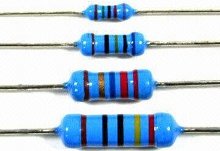Linear and non-linear resistive resistances
 Everything resistors are divided into linear and non-linear. Resistors whose resistances do not depend (i.e. do not change) on the value of the current flowing or the applied voltage are called linear. In communication equipment and other electronic devices (radio receivers, transistors, tape recorders, etc.) small linear resistors are widely used, for example type MLT (metallized, lacquered, resistant to heat). The resistance of these resistors remains unchanged when the voltages applied to them or currents flowing through them change and hence these resistors are linear.
Everything resistors are divided into linear and non-linear. Resistors whose resistances do not depend (i.e. do not change) on the value of the current flowing or the applied voltage are called linear. In communication equipment and other electronic devices (radio receivers, transistors, tape recorders, etc.) small linear resistors are widely used, for example type MLT (metallized, lacquered, resistant to heat). The resistance of these resistors remains unchanged when the voltages applied to them or currents flowing through them change and hence these resistors are linear.
Resistors whose resistance changes depending on the value, the applied voltage or the flowing current are called non-linear. Thus, the resistance of an incandescent lamp in the absence of current is 10-15 times less than with normal burning. TO non-linear elements include many semiconductor devices.

Thus, in linear resistive circuits, the shape of the current follows the shape of the voltage that caused that current.
Questions may arise: «Isn't it obvious that current and voltage have the same form? Isn't that natural? Why should this circumstance be specifically provided for?» We will answer these questions right away. The fact is that the current form repeats the voltage form only in one particular case, namely in linear resistive circuits.
In circuits with other elements, for example with capacitors, the current shape in the general case always differs from the shape of the applied voltage, therefore the matching of voltage and current shapes is the exception rather than the rule.
Remember that a linear resistive circuit is a special case where the current and voltage waveforms are identical, and the presence of such identity is relatively rare and not at all obvious.
In addition, it was experimentally established that in a linear resistive circuit, the current is inversely proportional to the resistance, that is, as the resistance increases a certain number of times (at constant voltage), the current decreases by the same number of times.The relationship between instantaneous currents i, instantaneous voltages and circuit resistance R is expressed by the formula

This ratio is called Ohm's law for a section of a circuit... Since the largest instantaneous values are called maximum, Ohm's law can take the form


where Im and Um are the maximum current and voltage values, respectively; Ip and Up — current and voltage.
In a particular case, voltages and currents may not change over time (constant current regime), then the values of instantaneous voltages become constant values, and they are denoted not and (ie, a lowercase letter, like any variable), a U (capital letter, the value of the value), in this particular case, Ohm's law is written as follows:

Thus, in the general case, for voltages and therefore currents of arbitrary shape, the basic form of the formula expressing Ohm's law must be used:

or

With time-constant voltages and currents

or

Important rule: Ohm's law for instantaneous values is valid only in resistive circuits.
Resistive elements irreversible converts electrical energy into heat, but they do not store any energy, so they are called non-energy intensive. From what has been said, it follows that Ohm's law for instantaneous values is valid only in circuits with elements that do not consume energy.
